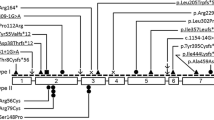Abstract
Data regarding outcome and therapy of pregnancies in patients with homozygous antithrombin (AT) deficiency are very rare. We conducted a retrospective, descriptive investigation with emphasis on the obstetric history of eight women with homozygous AT deficiency heparin-binding site (HBS), who had at least one pregnancy. The aim of the study was to get a better insight into the outcome and identify suitable management procedures of pregnancy in this rare disease. All patients suffered from homozygous AT deficiency caused by the mutation c.391C>T p.Leu131Phe in the AT gene (SERPINC1). The women reported in total 23 pregnancies; one pregnancy was excluded because of induced abortion. We found that only seven out of the 22 analyzed pregnancies ended with a live infant, all of them were born preterm. Among the 15 negative outcomes, seven were early pregnancy losses and eight were intrauterine fetal deaths. We found no clear association between treatment protocols and outcome. Eight pregnancies were not treated at all; all of them ended with pregnancy loss. We conclude that homozygous AT deficiency HBS, a form of severe thrombophilia, is associated with high risk of pregnancy loss and preterm delivery. Rigorous anticoagulation and/or replacement of AT during pregnancy may improve the outcome.

Similar content being viewed by others
References
Lockwood CJ (2002) Inherited thrombophilias in pregnant patients: detection and treatment paradigm. Obstet Gynecol 99(2):333–341
Patnaik MM, Moll S (2008) Inherited antithrombin deficiency: a review. Haemophilia: the official journal of the World Federation of Hemophilia 14(6):1229–1239. doi:10.1111/j.1365-2516.2008.01830.x
Kuhle S, Lane DA, Jochmanns K, Male C, Quehenberger P, Lechner K, Pabinger I (2001) Homozygous antithrombin deficiency type II (99 Leu to Phe mutation) and childhood thromboembolism. Thromb Haemost 86(4):1007–1011
Tait RC, Walker ID, Perry DJ, Islam SI, Daly ME, McCall F, Conkie JA, Carrell RW (1994) Prevalence of antithrombin deficiency in the healthy population. Br J Haematol 87(1):106–112
Middeldorp S (2007) Thrombophilia and pregnancy complications: cause or association? Journal of thrombosis and haemostasis: JTH 5:276–282
Roemisch J, Gray E, Hoffmann JN, Wiedermann CJ (2002) Antithrombin: a new look at the actions of a serine protease inhibitor. Blood Coagul Fibrinolysis 13(8):657–670
Rodgers GM (2009) Role of antithrombin concentrate in treatment of hereditary antithrombin deficiency. An update. Thrombosis and haemostasis 101(5):806–812
Maclean PS, Tait RC (2007) Hereditary and acquired antithrombin deficiency: epidemiology, pathogenesis and treatment options. Drugs 67(10):1429–1440
Rogenhofer N, Bohlmann MK, Beuter-Winkler P, Wurfel W, Rank A, Thaler CJ, Toth B (2014) Prevention, management and extent of adverse pregnancy outcomes in women with hereditary antithrombin deficiency. Ann Hematol 93(3):385–392. doi:10.1007/s00277-013-1892-0
Bates SM, Greer IA, Middeldorp S, Veenstra DL, Prabulos AM, Vandvik PO (2012) VTE, thrombophilia, antithrombotic therapy, and pregnancy: antithrombotic therapy and prevention of thrombosis, 9th ed: American College of Chest Physicians Evidence-Based Clinical Practice Guidelines. Chest 141(2 Suppl):e691S–e736S. doi:10.1378/chest.11-2300
Vossen CYPF, Conard J, Fontcuberta J, Makris M, van der Meer FJ, Pabinger I, Palareti G, Scharrer I, Souto JC, Svensson P, Walker ID, Rosendaal FR (2004) Hereditary thrombophilia and fetal loss: a prospective follow-up study. J Thromb Haemost 2:592–596
Olds RJ, Lane DA, Chowdhury V, Sas G, Pabinger I, Auberger K, Thein SL (1994) (ATT) trinucleotide repeats in the antithrombin gene and their use in determining the origin of repeated mutations. Hum Mutat 4(1):31–41. doi:10.1002/humu.1380040105
Virkus RA, Lokkegaard EC, Bergholt T, Mogensen U, Langhoff-Roos J, Lidegaard O (2011) Venous thromboembolism in pregnant and puerperal women in Denmark 1995–2005. A national cohort study. Thromb Haemost 106(2):304–309. doi:10.1160/th10-12-0823
Heit JA, Kobbervig CE, James AH, Petterson TM, Bailey KR, Melton LJ 3rd (2005) Trends in the incidence of venous thromboembolism during pregnancy or postpartum: a 30-year population-based study. Ann Intern Med 143(10):697–706
Kovac M, Mitic G, Miljic P, Mikovic Z, Mandic V, Djordjevic V, Radojkovic D, Bereczky Z, Muszbek L (2014) Poor pregnancy outcome in women with homozygous type-II HBS antithrombin deficiency. Thromb Res. doi:10.1016/j.thromres.2014.03.025
Henderson JT, Whitlock EP, O'Conner E, Senger CA, Thompson JH, Rowland MG (2014) Low-dose aspirin for the prevention of morbidity and mortality from preeclampsia: a systematic evidence review for the U.S. Preventive Services Task Force, Rockville
Pascual C, Munoz C, Huerta AR, Rus GP, Ortega V, Corral J, Diez-Martin JL (2014) A new case of successful outcome of pregnancy in a carrier of homozygous type II (L99F) antithrombin deficiency. Blood Coagul Fibrinolysis 25(1):74–76. doi:10.1097/MBC.0b013e3283646620
Alguel G, Jochmans K, Simanek R, Ay C, Quehenberger P, Langer M, Pabinger I (2007) Successful outcome in a pregnant woman with homozygous antithrombin deficiency. Thromb Haemost 98(6):1377–1378
Bauters A, Zawadzki C, Bura A, Thery C, Watel A, Subtil D, Aiach M, Emmerich J, Jude B (1996) Homozygous variant of antithrombin with lack of affinity for heparin: management of severe thrombotic complications associated with intrauterine fetal demise. Blood Coagul Fibrinolysis 7(7):705–710
van Driel D, Wesseling J, Sauer PJ, Touwen BC, van der Veer E, Heymans HS (2002) Teratogen update: fetal effects after in utero exposure to coumarins overview of cases, follow-up findings, and pathogenesis. Teratology 66(3):127–140. doi:10.1002/tera.10054
Gindele R, Olah Z, Ilonczai P, Speker M, Udvari A, Selmeczi A, Pfliegler G, Marjan E, Kovacs B, Boda Z, Muszbek L, Bereczky Z (2016) Founder effect is responsible for the p.Leu131Phe heparin-binding-site antithrombin mutation common in Hungary: phenotype analysis in a large cohort. Journal of thrombosis and haemostasis: JTH 14(4):704–715. doi:10.1111/jth.13252
Author information
Authors and Affiliations
Corresponding author
Ethics declarations
The ethics committee of the Medical University of Vienna approved the study (EK-number 1619/2014). Informed consent for being included in the study was obtained from all patients, who followed our invitation to a follow-up visit.
Conflict of interests
The authors state that they have no conflict of interest.
Rights and permissions
About this article
Cite this article
Kraft, J., Sunder-Plassmann, R., Mannhalter, C. et al. Women with homozygous AT deficiency type II heparin-binding site (HBS) are at high risk of pregnancy loss and pregnancy complications. Ann Hematol 96, 1023–1031 (2017). https://doi.org/10.1007/s00277-017-2965-2
Received:
Accepted:
Published:
Issue Date:
DOI: https://doi.org/10.1007/s00277-017-2965-2




